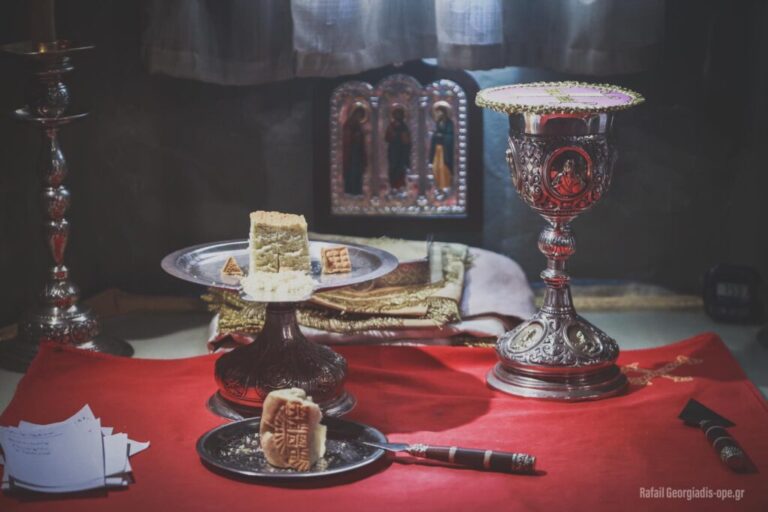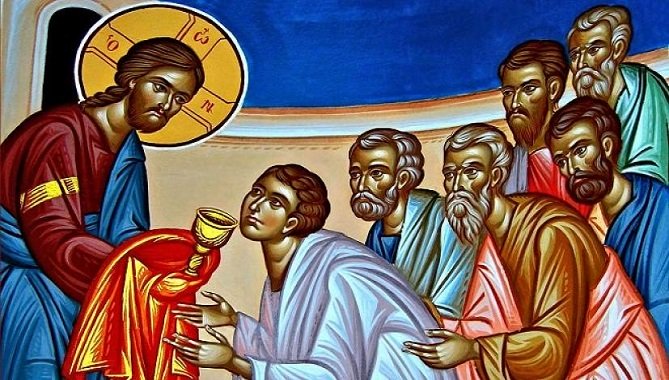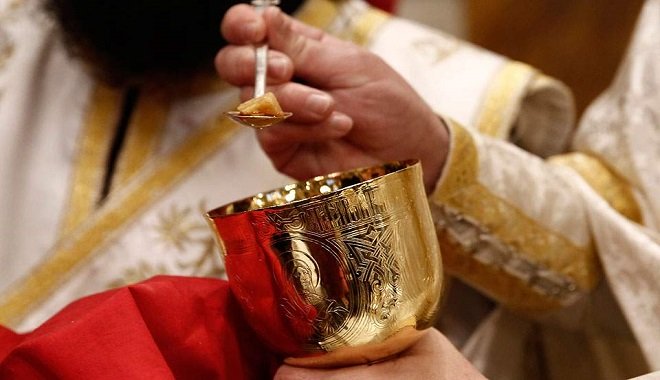‘We and Christ are One’
18 August 2020Interpreting the sacred texts of the Evangelists which refer to the Last Supper and the transmission of the dread mysteries, Saint John Chrysostom has this to say: ‘Believe that now, too, it’s the same supper as the one where Christ sat. That supper differs not in the slightest from the holy sacrament… Because it’s He Who offers both’ [1]. And the holy father continues, bringing his personal, Spirit-inspired experiences to his flock: ‘He Who worked the Mystery at the Last Supper is the same as performs the Sacrament of the Divine Liturgy… the holy altar is the same table as at the Last Supper and is not less in any way’ [2].
Allow me, then, to place in your loving hearts some wisdom from Patristic experience regarding the Sacred Mystery of the Divine Eucharist.

There’s a lot of talk today regarding this Sacred Mystery. Impious lips have even spoken during the pandemic which has afflicted the planet, saying that, together with the Body and Blood of Christ, it’s possible also to swallow the deadly virus. Centuries of experience have shown that an infectious disease has never been transmitted in this way, since we believe and confess that what we receive is the Body and Blood of Christ, given for the health of body and soul, for the remission of sins and life everlasting. Saint John Chrysostom is revealing on this point: ‘When you see the priest giving you the Holy Sacrament, don’t think it’s him who’s doing it. Believe rather that the hand being extended is that of Christ’ [3].
First of all, what is Holy Communion?
It’s the presence in our life of Christ the generous Giver. It’s the moment of our personal encounter with Christ Himself. When we approach to take the Spotless Mysteries, we imbibe immortal food, the Body and Blood of Christ. We don’t consume some of Christ’s gifts, but Christ Himself. We become one with His Body and Blood. ‘You embrace the Lord, you mingle with His Spotless Body, you’re kneaded together with the body which is in heaven… His most pure Blood is mixed with ours and transforms our soul so that the whole of our being becomes brighter than a flame and shines more than gold’ [4].
Precisely the same truth is stated by Saint Nikolaos Kavasilas: ‘And, indeed, the Sacraments are the Body and Blood of Christ, and for the Church they are our true meat and drink. Partaking of them does not change them into the human body, as is the case with other food, but the latter is changed into them, since the superior triumphs… If we could see, as regards this alone- the fact that Church of Christ is united with Christ and partakes of His flesh- we would see nothing other than the Body of Christ Itself [5].

Saint Gregory Palamas also confirms this union between us people and God: ‘What an incomparable and exceptional wonder. He unites Himself with the human person, mingling Himself with each of the faithful. How then, will He not illumine with the divine radiance of His body, which is now within us, the souls of those who commune worthily, as once He illumined the bodies of His disciples on Tabor?’ [6]. This is why the inexpressible Mystery of our union with God is described by Saint John Chrysostom in one phrase: ‘We and Christ are one’ [7].
It’s the weapon, the nourishment and the power in our everyday struggle. If soldiers are to rise to our high expectations of them, particularly in crucial battles, they need to be fed. In the same way, the soldiers of Christ are in need of the bread of life in the battles they wage against the principalities and powers of darkness. Our participation in the Spotless Mysteries is therefore not symbolic. We don’t merely partake of blessed bread but the very Body and Blood of Christ, which guarantee us the toughness we need to engage in the warfare we’re fighting on three fronts: ourselves, the world and the devil.
This weapon has been used by all Christians, throughout the centuries in order to face their persecutors.
This is what they wanted as their daily bread even when they were in prison.
This is what they received as provision for life eternal when they were led to the scaffold and places of execution. This is why, fearless, bold, with eyes raised to heaven they faced imminent death, which would unite them with the beloved Person of Christ the Savior. They behaved as real Christians, because they understood the heart of the Divine Liturgy, that is the mystery of the Divine Eucharist [8]. In other words, they really did experience what Patriarch Dositheos of Jerusalem states in his wonderful ‘Confession’: that the bread is transformed into the true body of the Lord ‘Who was born in Bethlehem of the Ever-Virgin, baptized in the Jordan, suffered, rose, ascended, sits on the right hand of God the Father and will come on the clouds of heaven… And the wine is altered in its essence into the very blood of the Lord, which was shed as He hung on the Cross, for the life of the world’ [9].
It’s the antidote to death and the medicine of life and immortality, according to Saint Ignatius the God-Bearer [10]. Saint Basil the Great calls it provision for eternal life [11]. Saint Cyril of Alexandria assures us that the Lord ‘hides life and has placed immortality in us, like a seed, completely removing all corruption from within us’ [12]. In his Dogmatics, Saint Justin, that confessor of the faith, makes the apt point: ‘The blood relationship, the union of one person with another, is effected in the human and divine body of Christ, in the Church, and in a particularly realistic and empirical manner, during the Divine Eucharist, as the partaking of the Body and Blood of Christ’ [13].
At these difficult times for the Orthodox, there’s no need to bombard people with issues of lack of faith. We should be reinforcing their faith, which is reasonable and beyond reason, but not rational, as some would have it.
There’s an event in the book ‘Miracles and Revelations from the Holy Monastery of the Paraclete’ which is related to our subject. It makes a telling point:
‘There are Christians who don’t want to take Holy Communion in case they catch germs! If this were the case, none of the priests would be alive, because at the end they drink the contents of the Holy Chalice, from which perhaps hundreds of the faithful have supped, many of them with various ailments. Yet no priest has ever been taken ill from that. The Body and Blood of the Lord are “consuming fire”.

One of the many instances which demonstrate this very clearly is the following.
When Metropolitan Panteleimon of Chios († 1962) was a preacher in Attica, he once went to serve at the Tuberculosis Clinic. The nurses brought him a platter with lots of little spoons. He asked what this was for and was told that the doctors had said he was to give communion to the patients with these, starting with the least affected and going on to the most gravely sick. He replied that this wasn’t necessary, since he had the Holy Spoon.
He gave communion to the patients as normal during the Divine Liturgy and then emerged at the Royal Gate, where he finished the remnants in the chalice. He did so for all of them to see, and for the doctors to understand that Holy Communion is fire that burns up everything’ [14].
So it behooves us, first and foremost, to have eyes of faith and our personal experience of this God-constituted Mystery. And then we have to present it, unsullied and pure, to our blessed flock. We must urge our people, after confession and genuine repentance, to come with fear of God, faith and love to the Sacrament of the Divine Eucharist. Christ doesn’t transmit germs, nor deadly viruses. Only life, light and the health of soul and body.






